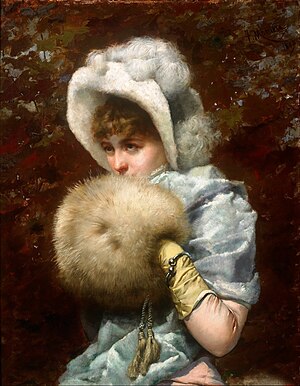Muff (handwarmer)
 From Wikipedia the free encyclopedia
From Wikipedia the free encyclopedia



A muff is a fashion accessory for outdoors usually made of a cylinder of fur or fabric with both ends open for keeping the hands warm. It was introduced to women's fashion in the 16th century and was popular with both men and women in the 17th and 18th centuries. By the early 19th century, muffs were used in Europe only by women.[1] It is also reported[according to whom?] that the fashion largely fell out of style in the 19th century.
It briefly returned in the mid-1940s,[2] and in the 1960s was developed as a motorcycle accessory for attachment as rider-protection and comfort during the cooler months.
History[edit]
In Roman times, the place of the glove was taken by long sleeves (manicae) reaching to the hand, and in winter special sleeves of fur were worn. In Medieval Latin we find the word muffulae, defined by Du Cange as chirothecae pellitae et hibernae ("leather winter gloves"). He quotes from a cartulary of the year 817, of the issuing to monks of sheepskin coverings to be used during the winter. These may have been, as the Roman certainly were, separate coverings for each hand, although the cartulary cited also distinguishes the glove for summer from the muffulae for winter wear. The Old French moufle meant a thick glove or mitten, and from this the Dutch mof, Walloon mouffe, and thence English "muff", are probably derived.[1]
In Elizabethan and Stuart England, the muff was sometimes called a "countenance" following a French usage. In 1579, Amias Paulet bought a fur "countenance" in Paris for Elizabeth I.[3]
Modern usage[edit]
Handlebar muffs are a utility product for motorcycles and scooters to provide increased comfort in adverse weather conditions, to protect the rider from rain and wind chill. With UK commercial-availability in the early 1960s,[4] they are still available in three variations from a UK merchandiser of motorcycle accessories, including dedicated-types for small motorscooters.[5]
Traditionally made from waterproof faux leather and lined for insulation, more-modern, textile-based materials are also used.[4][5][6][7]
When reviewing clothing and riding accessories in a 1966 feature entitled "Tough Weather Gear" for the weekly journal Motor Cycle, regular journalist John Ebbrell described the muffs as:[8][9]
Ugly as sin they may be—but there's nothing more cosier to the fingertips than a pair of handlebar muffs...Material is waterproof plasticized fabric, lined. Fitted in a jiffy, the muffs are sold through Pride and Clarke's and cost 17s 6d.
Writing at his website in December 2010, American motorcycle design innovator Craig Vetter claimed to have "created and developed" from 1971 what he called Hippo Hands, later sold to the public from 1973 by the Vetter organisation.[10][11] These were very similar to a product that was easily available to UK motorcyclists from retail shops/mail order outlets from 1957,[12] with the description handlebar muffs.[4][13][14][15][5][16]
References[edit]
- ^ a b Chisholm 1911, p. 955.
- ^ E-PATTERN - 1940s Beret Hat and Muff Bag Wearing History, Retrieved 8 January 2019
- ^ Janet Arnold, Queen Elizabeth's Wardrobe Unlock'd (Maney, 1998), 97.
- ^ a b c The Motor Cycle, 4 October 1962, Pride and Clarke single-page advert Special Offer - Handlebar muffs 12/6, postage 2/6, p.31 Accessed 1 December 2017
- ^ a b c Muffs, Oxford Products, Retrieved 1 December 2017
- ^ Tucano Urbano Handlebar Muffs Review Web Bike World, 22 March 2011. Retrieved 31 March 2021
- ^ Product review: Tucano Urbano R317 Muffs Motorcycle News. Retrieved 31 March 2021
- ^ Motor Cycle, 13 January 1966, Equipment for winter riding - Tough Weather Gear by John Ebrell, pp.32-34. Accessed 1 December 2017
- ^ Pride and Clarke, Car and Motorcycle Accessory Catalogue, undated, p.4 Accessed 1 December 2017
- ^ Hippo Hands (Archived from the original at craigvetter.com), Archived 1 May 2017, Retrieved 1 December 2017
- ^ Motorcycle Sport, March 1981, p.159 (pp.146-149, 159). Ninety Eight Point Four: Keeping warm on a motorcycle in winter. "A more refined (perhaps the best) handlebar muff is the Hippo-Hands, available from CTA, Unit 30E, 142A Virginia Street, Southport, Lancashire". Accessed 6 April 2020
- ^ The Motor Cycle, 7 March 1957, p.35. Claude Rye part-page advert NEW HANDLEBAR MUFFS Superior black waterproof leathercloth Handlebar Muffs, lined fleece, keep hands warm and dry. Pair 10/6. Deluxe pair 11/9, Post & Pkg. 1/6 M.P.C. Plastic 29/11 pair. P & P. 2/-. Accessed 12 September 2019
- ^ Motor Cycle, 21 February 1963, Pride and Clarke double-page advert Handlebar muffs 17/6, postage 2/6, pp.23-24 Accessed 1 December 2017
- ^ Motor Cycle, 21 February 1963, You say this reader's letters "Heated Muffs Experiment", p.230 Accessed 1 December 2017
- ^ Motor Cycle, 4 November 1965, Pride and Clarke double-page advert, Handlebar muffs 17/6, postage 3/0, p.18 Accessed 1 December 2017
- ^ Motorcycle Sport, March 1981, p.149 (pp.146-149), 159. Ninety Eight Point Four: Keeping warm on a motorcycle in winter. Accessed 6 April 2020
Bibliography[edit]
- This article incorporates text from a publication now in the public domain: Chisholm, Hugh, ed. (1911). "Muff". Encyclopædia Britannica. Vol. 18 (11th ed.). Cambridge University Press. p. 955.
